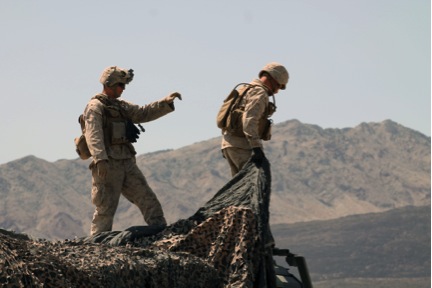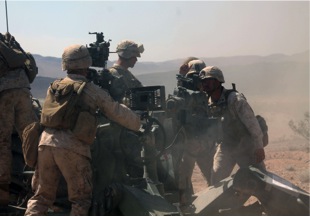TWENTYNINE PALMS, Calif. — Marines stationed at Southern California’s Twentynine Palms base who are ordered to move to a sleepy little town in the Mojave Desert do so willingly for one overriding reason — the Twentynine Palms Marine Corps Air Ground Combat Center provides an unparalleled opportunity through its live-fire training regimen.
On an early spring morning before the sun had risen and while the desert air was still cool, I entered the base, strapped on a Marine-issued kevlar vest, donned a combat helmet and listened to my desert-survival instructions before hopping into the back of a covered seven-ton truck. We traveled roughly 40 miles from the base’s main gate to join Marines in the midst of one of those live-fire training exercises.
My mission: To observe how Twentynine Palms-style training prepares a Marine for the theater of war.
The value of the training is “all about effects and execution,” said Capt. Andrew Reaves, the Kilo Battery commander for the 3rd Battalion, 11th Marines. In this role, he oversaw the training Marines fire artillery.
The effects and execution included one battery of howitzers positioned southeast of the command center, from which officers would deliver orders to fire on the “enemy,” hidden in the mountains some 10 kilometers, or “klicks,” east. The logistics team, responsible for delivering rations, ammunition and medial care, sat segregated, just shy of a klick from command. A number of Humvees and seven-tons were scattered around the training site.
The 3rd Battalion, 11th Marines trained as a maneuvering force able to provide artillery support to infantry.
A round fired from a howitzer can hit a target with GPS-guided accuracy up to 18,000 meters away, leaving a prolonged moment of silence between the shell’s exit and its loud impact. A good crew can repeat this process every 30 seconds and relocate the weapon in as little as three minutes, according to Reaves.
The howitzers did not, however, always fire lethal ammunition on this day. The weapons also delivered smoke screens, created by firing shells that would explode above the enemy and release smoke as opposed to ordnance. The screens effectively blind the enemy and hide Marines on the ground.
The length of a howitzer shell’s fuse determines the timing of the shell’s explosion, regardless of its purpose.
The entire battery, which on this particular day included four howitzers and several seven-ton trucks, can pack up, deploy and re-engage the enemy from a new location in a matter of
minutes.
When comparing the similarities of this training to the theater of war in the Middle East, a young first lieutenant said it is “very realistic, especially in this environment.”
The conditions were rough. Cracked lips, burnt necks and dust-covered faces appeared to be a right of passage for the Marines on this expedition, which carried on for two weeks. They slept under the stars in sleeping bags, with no tents to shelter them, as the temperature dropped from a high of roughly 70 to the mid-40s.
Capt. Rich Whalen, a Marine who has served for 10 years, agreed with the lieutenant. The Mojave’s topography and isolation supports training exercises that would not otherwise be possible, according to Whalen.
Twentynine Palms training “supersedes anything else the Marine Corps has,” Whalen said.







